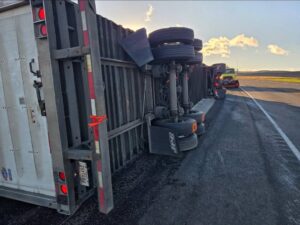AUSTIN, Texas — Holiday weekends bring notoriously high risks for both manufacturers and the freight industry. Organized cargo theft rings will be extremely active this week, as more shipments are left unattended for extended periods of time due to the upcoming Thanksgiving holiday.
During Thanksgiving holiday weekends between 2015 and 2019, the Sensitech Supply Chain Intelligence Center (SCIC) recorded nearly three thefts per day, a rate that’s 53% higher than the rest of the year. The reported thefts were primarily electronics (23%), but home and garden items (15%) were also popular targets.
The following are only a few notable Thanksgiving-weekend thefts that took place in the U.S. between 2015 and 2019:
- 2015, Louisiana: Full truckload of televisions ($380,000);
- 2015, Georgia: Pilferage of televisions ($100,000);
- 2016, New Jersey: Full truckload of footwear ($414,000);
- 2017, California: Facility theft of spirits ($300,000);
- 2017, Tennessee: Full truckload of televisions ($296,000);
- 2017, Florida: Facility theft of spirits ($481,000);
- 2017, Illinois: Pilferage of televisions ($150,000);
- 2018, California: Full truckload of televisions ($293,000);
- 2018, Texas: Full truckload of vehicles ($120,000);
- 2019, Alabama: Full truckload of food and drinks ($100,000; and
- 2019, Mississippi: Full truckload of home and garden ($100,000).
The Sensitech SCIC recommends that logistics and security professionals ensure security protocols are up to date and in line with industry best practices for both in-transit and warehouse operations. To mitigate criminal attempts to exploit cargo at rest, Sensitech suggests confirming that a given receiver’s hours of operation for the holiday weekend are consistent with scheduled delivery times; it’s also important to plan for secure parking locations in the event a shipment will have to stop for an extended period of time. Covert GPS tracking and active monitoring of high-value shipments are highly recommended, as these techniques have proven to be the most effective protocols to both mitigate in-transit theft and facilitate successful recovery of stolen product.
To help drivers and motor carriers secure their loads, the following guidelines are collectively endorsed by Sensitech, IMUA, PCSC, Travelers Insurance, SWTSC, SETSC, NETSC and the Cargo Security Alliance:
- Steps should be taken to verify the authenticity of all shipment-related activity during these periods — particularly any entity that has been engaged to either move or store a shipment. Obtaining driver and business verification, prior to releasing any shipment, is paramount.
- Communication between drivers and shippers needs to be firmly established and regularly maintained during shipments over these periods. That communication should include instructing drivers as to what types of behavior are required and what is not permissible.
- Truck stops, highway rest areas and distribution centers are traditionally frequent targets for cargo thieves, and more so over holiday periods. Any location where cargo could either intentionally (or unintentionally) come to rest — even for brief periods of time — should be as secure as possible. Things to consider when selecting a secure area/lot include controlled access, adequate lighting, congestion, any type of either personal or video surveillance, how long the conveyance will be left unattended, and past intelligence of localized cargo theft activity.
- If a cargo conveyance must be left unattended for any period of time, it should be made as secure as possible. Consider using theft-resistant locking/sealing mechanisms for tractors, trailers and cargo compartments; disabling technology for the vehicle’s power units or trailer movements; and parking vehicles and/or cargo compartments in a fashion which make access as difficult as possible.
- If any tracking technology, such as GPS monitoring, that is available for deployment should be used to its fullest extent possible. That would include tracking technology on the conveyance’s power unit and its cargo area (if separate), as well as within the cargo itself.
The Trucker News Staff produces engaging content for not only TheTrucker.com, but also The Trucker Newspaper, which has been serving the trucking industry for more than 30 years. With a focus on drivers, the Trucker News Staff aims to provide relevant, objective content pertaining to the trucking segment of the transportation industry. The Trucker News Staff is based in Little Rock, Arkansas.















